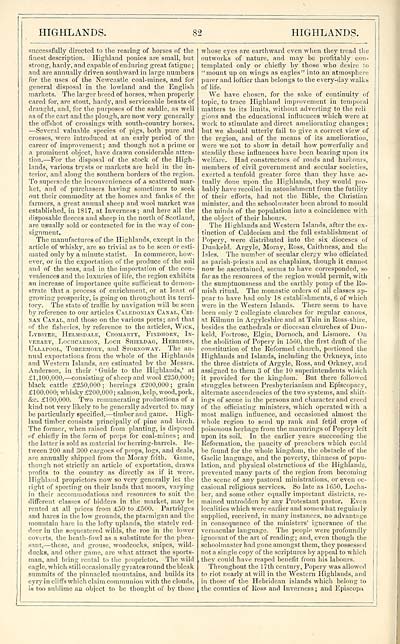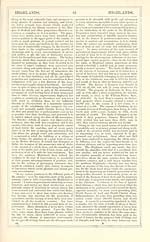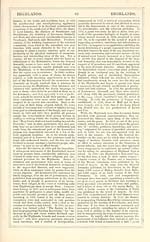Imperial gazeteer of Scotland, or, Dictionary of Scottish topography > Volume 2
(98) Page 82 - HIG
Download files
Complete book:
Individual page:
Thumbnail gallery: Grid view | List view

HIGHLANDS.
82
HIGHLANDS.
successfully directed to the rearing of horses of the
finest description. Highland ponies are small, but
strong, hardy, and capable of enduring great fatigue ;
and are annually driven southward in large numbers
for the uses of the Newcastle coal-mines, and for
general disposal in the lowland and the English
markets. The larger breed of horses, when properly
cared for, are stout, hardy, and serviceable beasts of
draught, and, for the purposes of the saddle, as well
as of the cart and the plough, are now very generally
the offshot of crossings with south-country horses.
— Several valuable species of pigs, both pure and
crosses, were introduced at an early period of the
career of improvement; and though not a prime or
a prominent object, have drawn considerable atten-
tion. — For the disposal of the stock of the High-
lands, various trysts or markets are held in the in-
terior, and along the southern borders of the region.
To supersede the inconveniences of a scattered mar-
ket, and of purchasers having sometimes to seek
out their commodity at the homes and fanks of the
farmers, a great annual sheep and wool market was
established, in 1817, at Inverness; and here all the
disposable fleeces and sheep in the north of Scotland,
are usually sold or contracted for in the way of con-
signment.
The manufactures of the Highlands, except in the
article of whisky, are so trivial as to be seen or esti-
mated only by a minute statist. In commerce, how-
ever, or in the exportation of the produce of the soil
and of the seas, and in the importation of the con-
veniences and the luxuries of life, the region exhibits
an increase of importance quite sufficient to demon-
strate that a process of enrichment, or at least of
growing prosperity, is going on throughout its terri-
tory. The state of traffic by navigation will be seen
by reference to our articles Caledonian Canal, Chi-
nan Canal, and those on the various ports; and that
of the fisheries, by reference to the articles, Wick,
Lybster, Helmsdale, Cromarty, Findhorn, In-
verary, lochcarron, looh suieldag, hebrides,
Ullapool, Tobermory-, and Stornoway. The an-
nual exportations from the whole of the Highlands
and Western Islands, are estimated by the Messrs.
Anderson, in their ' Guide to the Highlands,' at
£1,100,000,— consisting of sheep and wool £250,000;
black cattle £250,000; herrings £200,000; grain
£100,000; whisky £200,000; salmon, kelp, wood, pork,
&c. £100,000. Two remunerating productions of a
kind not very likely to be generally adverted to. may
be particularly specified, — timber and game. High-
land timber consists principally of pine and birch.
The former, when raised from planting, is disposed
of chiefly in the form of props for coal-mines ; and
the latter is sold as material for herring-barrels. Be-
tween 200 and 300 cargoes of props, logs, and deals,
are annually shipped from the Moray frith. Game,
though not strictly an article of exportation, draws
profits to the country as directly as if it were.
Highland proprietors now so very generally let the
right of sporting on their lands that moors, varying
in their accommodations and resources to suit the
different classes of bidders in the market, may be
rented at all prices from £50 to £500. Partridges
and hares in the low grounds, the ptarmigan and the
mountain hare in the lofty uplands, the stately red-
deer in the sequestered wilds, the roe in the lower
coverts, the heath-fowl as a substitute for the phea-
sant, — these, and grouse, woodcocks, snipes, wild-
ducks, and other game, are what attract the sports-
man, and bring rental to the proprietor. The wild
eagle, which still occasionally gyrates round the bleak
summits of the pinnacled mountains, and builds its
eyry in cliffs which claim communion with the clouds,
is too sublime an object to be thought of by those
whose eyes are earthward even when they tread the
outworks of nature, and may be profitably con-
templated only or chiefly by those who desire to
"mount up on wings as eagles" into an atmosphere
purer and loftier than belongs to the every-day walks
of life.
"We have chosen, for the sake of continuity of
topic, to trace Highland improvement in temporal
matters to its limits, without adverting to the reli
gions and the educational influences which were at
work to stimulate and direct ameliorating changes;
but we should utterly fail to give a correct view of
the region, and of the means of its amelioration,
were we not to show in detail how powerfully and
steadily these influences have been bearing upon its
welfare. Had constructors of roads and harbours,
members of civil government and secular societies,
exerted a tenfold greater force than they have ac-
tually done upon the Highlands, they would pro-
bably have recoiled in astonishment from the futility
of their efforts, had not the Bible, the Christian
minister, and the schoolmaster been abroad to mould
the minds of the population into a coincidence with
the object of their labours.
The Highlands and Western Islands, after the ex-
tinction of Culdeeism and the full establishment of
Popery, were distributed into the six dioceses of
Dunkeld. Argyle, Moray, Boss, Caithness, and the
Isles. The number of secular clergy who officiated
as parish-priests and as chaplains, though it cannot
now be ascertained, seems to have corresponded, so
far as the resources of the region would permit, with
the snmptuousness and the earthly pomp of the Ro-
mish ritual. The monastic orders of all classes ap-
pear to have had only 18 establishments, 6 of which
were in the Western Islands. There seem to have
been only 2 collegiate churches for regular canons,
at Kilmun in Argyleshire and at Tain in Boss-shire,
besides the cathedrals or diocesan churches of Dun-
keld, Fortrose, Elgin, Dornoch, and Lismore. On
the abolition of Popery in 1560. the first draft of the
constitution of the Reformed church, portioned the
Highlands and Islands, including the Orkneys, into
the three districts of Argyle, Boss, and Orkney, and
assigned to them 3 of the 10 superintendents which
it provided for the kingdom. But there followed
struggles between Presbyterianism and Episcopacy,
alternate ascendencies of the two systems, and shirt-
ings of scene in the persons and character and creed
of the officiating ministers, which operated with a
most malign influence, and occasioned almost the
whole region to send up rank and fetid crops of
poisonous herbage from the manurings of Popery left
upon its soil. In the earlier years succeeding the
Reformation, the paucity of preachers which could
be found for the whole kingdom, the obstacle of the
Gaelic language, and the poverty, thinness of popu-
lation, and physical obstructions of the Highlands,
prevented many parts of the region from becoming
the scene of any pastoral ministrations, or even oc-
casional religious services. So late as 1650, Loeha-
ber, and some other equally important districts, re-
mained untrodden by any Protestant pnstor. Even
localities which were earlier and somewhat regularly
supplied, received, in many instances, no advantage
in consequence of the ministers' ignorance of the
vernacular language. The people were profoundly
ignorant of the art of reading; and, even though the
schoolmaster bad gone amongst them, they possessed
not a single copy of the scriptures by appeal to which
they could have reaped benefit from his labours.
Throughout the 17th century, Popery was allowed
to riot nearly at will in the Western Highlands, and
in those of the Hebridean islands which belong to
the counties of Ross and Inverness ; and Episcopa
82
HIGHLANDS.
successfully directed to the rearing of horses of the
finest description. Highland ponies are small, but
strong, hardy, and capable of enduring great fatigue ;
and are annually driven southward in large numbers
for the uses of the Newcastle coal-mines, and for
general disposal in the lowland and the English
markets. The larger breed of horses, when properly
cared for, are stout, hardy, and serviceable beasts of
draught, and, for the purposes of the saddle, as well
as of the cart and the plough, are now very generally
the offshot of crossings with south-country horses.
— Several valuable species of pigs, both pure and
crosses, were introduced at an early period of the
career of improvement; and though not a prime or
a prominent object, have drawn considerable atten-
tion. — For the disposal of the stock of the High-
lands, various trysts or markets are held in the in-
terior, and along the southern borders of the region.
To supersede the inconveniences of a scattered mar-
ket, and of purchasers having sometimes to seek
out their commodity at the homes and fanks of the
farmers, a great annual sheep and wool market was
established, in 1817, at Inverness; and here all the
disposable fleeces and sheep in the north of Scotland,
are usually sold or contracted for in the way of con-
signment.
The manufactures of the Highlands, except in the
article of whisky, are so trivial as to be seen or esti-
mated only by a minute statist. In commerce, how-
ever, or in the exportation of the produce of the soil
and of the seas, and in the importation of the con-
veniences and the luxuries of life, the region exhibits
an increase of importance quite sufficient to demon-
strate that a process of enrichment, or at least of
growing prosperity, is going on throughout its terri-
tory. The state of traffic by navigation will be seen
by reference to our articles Caledonian Canal, Chi-
nan Canal, and those on the various ports; and that
of the fisheries, by reference to the articles, Wick,
Lybster, Helmsdale, Cromarty, Findhorn, In-
verary, lochcarron, looh suieldag, hebrides,
Ullapool, Tobermory-, and Stornoway. The an-
nual exportations from the whole of the Highlands
and Western Islands, are estimated by the Messrs.
Anderson, in their ' Guide to the Highlands,' at
£1,100,000,— consisting of sheep and wool £250,000;
black cattle £250,000; herrings £200,000; grain
£100,000; whisky £200,000; salmon, kelp, wood, pork,
&c. £100,000. Two remunerating productions of a
kind not very likely to be generally adverted to. may
be particularly specified, — timber and game. High-
land timber consists principally of pine and birch.
The former, when raised from planting, is disposed
of chiefly in the form of props for coal-mines ; and
the latter is sold as material for herring-barrels. Be-
tween 200 and 300 cargoes of props, logs, and deals,
are annually shipped from the Moray frith. Game,
though not strictly an article of exportation, draws
profits to the country as directly as if it were.
Highland proprietors now so very generally let the
right of sporting on their lands that moors, varying
in their accommodations and resources to suit the
different classes of bidders in the market, may be
rented at all prices from £50 to £500. Partridges
and hares in the low grounds, the ptarmigan and the
mountain hare in the lofty uplands, the stately red-
deer in the sequestered wilds, the roe in the lower
coverts, the heath-fowl as a substitute for the phea-
sant, — these, and grouse, woodcocks, snipes, wild-
ducks, and other game, are what attract the sports-
man, and bring rental to the proprietor. The wild
eagle, which still occasionally gyrates round the bleak
summits of the pinnacled mountains, and builds its
eyry in cliffs which claim communion with the clouds,
is too sublime an object to be thought of by those
whose eyes are earthward even when they tread the
outworks of nature, and may be profitably con-
templated only or chiefly by those who desire to
"mount up on wings as eagles" into an atmosphere
purer and loftier than belongs to the every-day walks
of life.
"We have chosen, for the sake of continuity of
topic, to trace Highland improvement in temporal
matters to its limits, without adverting to the reli
gions and the educational influences which were at
work to stimulate and direct ameliorating changes;
but we should utterly fail to give a correct view of
the region, and of the means of its amelioration,
were we not to show in detail how powerfully and
steadily these influences have been bearing upon its
welfare. Had constructors of roads and harbours,
members of civil government and secular societies,
exerted a tenfold greater force than they have ac-
tually done upon the Highlands, they would pro-
bably have recoiled in astonishment from the futility
of their efforts, had not the Bible, the Christian
minister, and the schoolmaster been abroad to mould
the minds of the population into a coincidence with
the object of their labours.
The Highlands and Western Islands, after the ex-
tinction of Culdeeism and the full establishment of
Popery, were distributed into the six dioceses of
Dunkeld. Argyle, Moray, Boss, Caithness, and the
Isles. The number of secular clergy who officiated
as parish-priests and as chaplains, though it cannot
now be ascertained, seems to have corresponded, so
far as the resources of the region would permit, with
the snmptuousness and the earthly pomp of the Ro-
mish ritual. The monastic orders of all classes ap-
pear to have had only 18 establishments, 6 of which
were in the Western Islands. There seem to have
been only 2 collegiate churches for regular canons,
at Kilmun in Argyleshire and at Tain in Boss-shire,
besides the cathedrals or diocesan churches of Dun-
keld, Fortrose, Elgin, Dornoch, and Lismore. On
the abolition of Popery in 1560. the first draft of the
constitution of the Reformed church, portioned the
Highlands and Islands, including the Orkneys, into
the three districts of Argyle, Boss, and Orkney, and
assigned to them 3 of the 10 superintendents which
it provided for the kingdom. But there followed
struggles between Presbyterianism and Episcopacy,
alternate ascendencies of the two systems, and shirt-
ings of scene in the persons and character and creed
of the officiating ministers, which operated with a
most malign influence, and occasioned almost the
whole region to send up rank and fetid crops of
poisonous herbage from the manurings of Popery left
upon its soil. In the earlier years succeeding the
Reformation, the paucity of preachers which could
be found for the whole kingdom, the obstacle of the
Gaelic language, and the poverty, thinness of popu-
lation, and physical obstructions of the Highlands,
prevented many parts of the region from becoming
the scene of any pastoral ministrations, or even oc-
casional religious services. So late as 1650, Loeha-
ber, and some other equally important districts, re-
mained untrodden by any Protestant pnstor. Even
localities which were earlier and somewhat regularly
supplied, received, in many instances, no advantage
in consequence of the ministers' ignorance of the
vernacular language. The people were profoundly
ignorant of the art of reading; and, even though the
schoolmaster bad gone amongst them, they possessed
not a single copy of the scriptures by appeal to which
they could have reaped benefit from his labours.
Throughout the 17th century, Popery was allowed
to riot nearly at will in the Western Highlands, and
in those of the Hebridean islands which belong to
the counties of Ross and Inverness ; and Episcopa
Set display mode to: Large image | Transcription
Images and transcriptions on this page, including medium image downloads, may be used under the Creative Commons Attribution 4.0 International Licence unless otherwise stated. ![]()
| Gazetteers of Scotland, 1803-1901 > Imperial gazeteer of Scotland, or, Dictionary of Scottish topography > Volume 2 > (98) Page 82 - HIG |
|---|
| Permanent URL | https://digital.nls.uk/97471854 |
|---|
| Attribution and copyright: |
|
|---|---|

